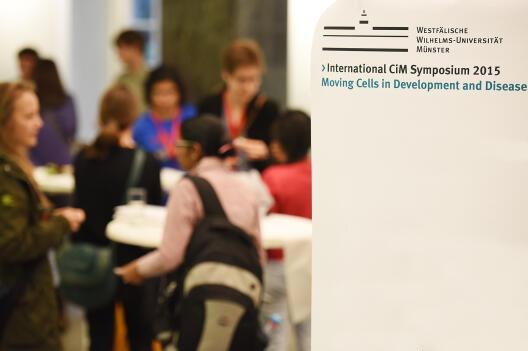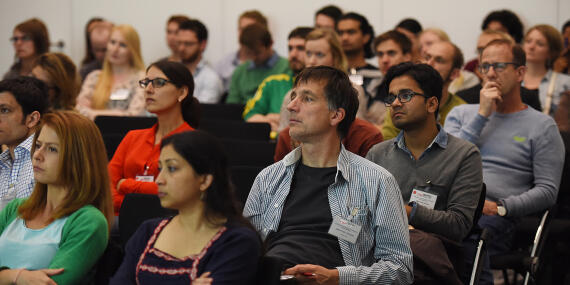Programm
Sunday, 13.09.2015
Place: Castle of Münster („Schloss“), Schlossplatz 2
| 16:00 |
Registration in the foyer |
| Presentations in the Aula |
| 17:00 |
Welcome |
| 17:15 |
Ruth Lehmann (New York University School of Medicine)
Lipid mediated migration of germ cells |
| 17:45 |
Fiona Watt (King‘s College London)
Moving epidermal cells |
| 18:15 |
Michael Sixt (Institute of Science and Technology Austria)
Cytoskeletal responses to external load in migrating cells |
| 19:00 |
Reception in the foyer |
Monday, 14.09.2015
Place: Auditorium of the MPI for Molecular Biomedicine, Röntgenstraße 20
| 8:00 |
Registration |
Session 1: Disease I
(Chair: Andreas Jacobs)
|
| 9:00 |
Steffen Massberg (Ludwig-Maximilians-Universität München)
Cell migration to vascular lesions |
| 9:30 |
Erik Sahai (The Francis Crick Institute)
Heterotypic cell-cell contacts in cancer invasion |
| 10:00 |
Andrew Luster (Massachusetts General Hospital)
Imaging chemokine function in disease |
| 10:30 |
Coffee break |
Session 2: Imaging I
(Chair: Roland Wedlich-Söldner)
|
| 11:00 |
Gero Miesenböck (University of Oxford)
Lighting up the brain |
| 11:30 |
Mandy Großgarten (University of Münster)
Elemental bioimaging by means of LA-ICP-MS to visualize nanoparticle uptake by alveolar macrophages in vivo and in vitro |
| 11:45 |
Jan Huisken (MPI of Molecular Cell Biology and Genetics)
Keeping track of cells in motion by smart and gentle microscopy |
| 12:15 |
Lunch |
Session 3: Imaging II
(Chair: Sebastian Rumpf)
|
|
13:45
|
Lydia Sorokin (University of Münster)
Imaging of matrix metalloproteinase (MMP)-2 and MMP-9 activity as a marker of neuroinflammation in mouse and man |
| 14:05 |
Christian Bökel (Center for Regenerative Therapies Dresden)
Location is everything - subcellular protein distribution and signal transduction |
| 14:35 |
Milos Galic (University of Münster)
Differential control of actin polymerization dynamics via nanoscale membrane curvature |
| 14:50 |
Break to change session |
Session 4: Intracellular Space
(Chair: Milos Galic)
|
|
15:00
|
Mark Peifer (The University of North Carolina)
Cytoskeletal regulation from molecules to morphogenesis |
| 15:30 |
Maja Matis (University of Münster)
Microtubule mechanics in development |
| 15:45 |
Ewa Paluch (University College London)
Forces during migration without focal adhesions |
| 16:15 |
Sebastian Rumpf (University of Münster)
Microtubule disruption during Drosophila sensory neuron dendrite pruning |
| 16:30 |
Coffee break |
Session 5: Cell Migration & Communication I
(Chair: Wiebke Herzog)
|
|
17:00
|
Carole Parent (National Cancer Institute)
Signal relay is mediated by exosome release during Dictyostelium and neutrophil chemotaxis |
| 17:30 |
Roland Wedlich-Söldner (University of Münster)
Rapid actin reorganization as a key mediator of acute calcium response in mammalian cells |
| 17:50 |
Roberto Mayor (University College London)
Cell-cell interaction controls neural crest migration |
| 18:20 |
Marianne Bronner (California Institute of Technology)
Molecular mechanisms underlying neural crest formation and migration |
Tuesday, 15.09.2015
Place: Auditorium of the MPI for Molecular Biomedicine, Röntgenstraße 20
| 8:00 |
Registration |
Session 6: Cell Migration & Communication II
(Chair: Friedemann Kiefer)
|
|
9:00
|
Daria Siekhaus (Institute of Science and Technology Austria)
Cytokine modulation of Drosophila macrophage tissue penetration |
| 9:30 |
Sven Bogdan (University of Münster)
Shaping cells in vivo – insights from the fly |
| 9:50 |
Timo Betz (University of Münster)
The role of mechanical tension in cancer cell invasion |
| 10:05 |
Coffee break |
Session 7: Cell Migration & Communication III
(Chair: Arndt Siekmann )
|
| 10:35 |
Klaus Brinkmann (University of Münster)
WHAMY is a novel WASP-like actin elongator regulating macrophage cell motility and sensory organ development in Drosophila |
| 10:50 |
Robert Insall (Cancer Research UK Beatson Institute)
Self-generated chemotactic gradients - a core mechanism of cell guidance in cancer and development |
| 11:20 |
Carl-Philipp Heisenberg (Institute of Science and Technology Austria)
Cell and tissue mechanics in zebrafish gastrulation |
| 11:50 |
Wiebke Herzog (University of Münster)
Novel regulators of angioblast migration |
| 12:10 |
Lunch |
Session 8: Disease II
(Chair: Friedemann Kiefer)
|
|
13:30
|
Taija Mäkinen (Uppsala University)
Mechanisms of lymphvasculogenic vessel formation |
| 14:00 |
Tatiana Petrova (University of Lausanne)
Biomechanical and transcriptional regulation of lymphatic vasculature |
| 14:30 |
Selina Fassl (University of Münster)
Cytoskeletal interactions in autoinflammatory diseases |
| 14:45 |
Coffee break |
Session 9: Disease III
(Chair: Erez Raz)
|
| 15:00 |
Alan Burns (University College London)
The enteric nervous system: development and congenital disease |
| 15:30 |
Azadeh Paksa (University of Münster)
Control of progenitor cell positioning during organogenesis |
| 16:30 |
Social event: Guided walking tour through the historic city centre |
Social Event: Geführter Stadtrundgang
Sprecherinnen und Sprecher sowie wie Besucherinnen und Besucher des Symposiums sind herzlich eingeladen, am Dienstagnachmittag, den 15. September, an einem geführten Rundgang in Münsters Altstadt teilzunehmen. Die Führung beginnt um 16:30 Uhr und dauert etwa 90 Minuten. Sie findet auf Englisch statt. Wir werden den Rundgang vor der zentral gelegenen Dominikanerkirche beenden, wo die Teilnehmenden Gelegenheit haben werden, die Ausstellung „Innere Welten – Zellen in Bewegung von Mikro bis Makro“ zu besuchen.










